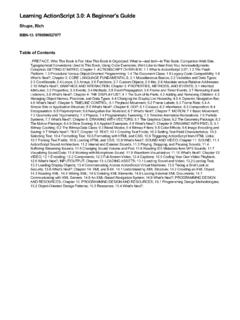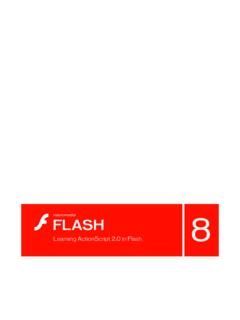Transcription of ActionScript 3.0 for Designers - fmaonline.com
1 ActionScript for Designers Wednesday, September 19 10:45 12:00 Room 1 This is a skeletal outline, with select example code segments, to accompany the presentation notes for ActionScript for Designers . To check for more up-to-date materials, visit: I hope to give you a fast-paced, information-packed look at Action Script from a new user's perspective. If you are already familiar with AS3, you will likely be bored to slumber in this presentation. However, if you are just getting started particularly within the Flash CS3 environment, in which this presentation is grounded you may get more out of it. Please feel free to shout out questions as we go, but please also be prepared for me to defer them until the end of the presentation, if time is tight.
2 I'll try to monitor our progress and adjust our pace if needed. To get the most out of our meeting, try to sit back and soak it in from a big picture perspective. I'll make these notes, and accompanying source files, available at the url above, so you don't have to worry about recording everything we discuss. Finally, all of the material in this presentation is distilled from learning ActionScript , published by O'Reilly, and co-written with Zevan Rosser. It should be available, in one form or another, by the time of this session. I . I N T R O D U C T I O N The Good You re among friends. You can still code in the Timeline.
3 AS3 is: More Consistent More Powerful A Lot Faster Closer to Other Languages Stricter (Better Error Reporting) The Bad AS3 is: Stricter (Initially Frustrating) More Verbose Some things have really changed or are gone A few examples: Initially a pain: ReleaseOutside/MouseUpOutside, .. No problem: eval(), _level, .. Adjustments needed, if you relied on: _global, .. A bit more work: Color class, Key object, .. You re facing a bigger learning curve We only have 75 The Ugly AS1/AS2 and AS3 are Not Compatible Two separate virtual machines in Player Communication only through indirect means ( LocalConnections) You May Need to Straddle the AS2/AS3 Fence To support legacy projects or ongoing existing development If you can t afford to focus your learning on one version Flash Platform Diverging and Converging Initial disparity between Flash and Flex still a problem, but improving Example Issues: Different component sets Different authoring techniques (embedding and more) Improvements.
4 Flex Component Kit for Flash CS3 Disparity to a lesser degree with AIR development, also improving Can now author AIR apps in Flash CS3 We only have 75 minutes!! I I . CO D E P L A C E ME N T NOTE: Some content herein will be explained in a little later on, as time allows. Timeline No More Stage Coding Cannot apply scripts directly to MC or Button -- on(), onClipEvent() (This is a good thing, so nut up.) Frame Scripts Business as usual (perhaps a few more imports?) Stage Instances Auto-Declared Handy for simple timeline scripts Can get in the way when declaring/typing instance variables Can be disabled in Publish Settings: Can now adjust frame rate at runtime = 30; Example (movie clip instantiated as mc on stage): = 2; //note revised property name and 0-1 percentage scale Symbol Instances Simplified Linkage Process Everything accomplished through Class and Base class In conjunction with the Display List, this is great.
5 Ball class (in external class file called in same directory): package { import ; public class Ball extends Sprite { public function Ball() { = 2; //note use of this instead of instance name } } } Document Class Easier Entr e into OOP Timeline Class Example (in external class file called in same directory): package { import ; public class Main extends MovieClip { public function Main() { trace("FlashForward Boston 2007"); } } } Instantiation (and Static, etc.) //in timeline, document class, or other class var particle:Particle = new Particle(); //in external class package { import ; public class Particle extends Sprite { public function Particle() { //particle physics here } } } I II.
6 D A T A T Y P I N G Tell Flash compiler and Player what type of data will be in use at a given moment. Mandatory Better Error Reporting Compile-Time Runtime Example: var userName:String = "Rich"; trace(userName*3); //error: 1067: Implicit coercion of a value of type String to an unrelated type Number. I V . D I S P L A Y L I S T Easily create display objects. Everything is now accomplished with new() var mc:MovieClip = new MovieClip(); Easily add and remove display objects, including depth management addChild(mc) //automatically add to top of visual stack removeChildAt(0) //remove from specific depth ( lowest) Easily re-parent children CODE (mc3) (mc3) Take advantage of new display object types A couple of examples: Dynamically create shapes A sprite is a one-frame movie clip Object vs.
7 Container Display object containers can have children All display object containers are display objects, but not vice versa Cast display objects when necessary MovieClip(obj).gotoAndStop(1); V . E v e n t s Listeners No more onEventHandlers. All events are now handled by the EventDispatcher, using event listeners Their use is the same as in AS2, but they are not confined to custom objects (for use with components, EventDispatcher, etc.) Flow Events cascade through the display list, divided into two phases: Capture and Target which consists of event propagation from the senior-most object (the stage, for example) down to the target (such as a button clicked by the user).
8 Bubbling when the event bubbles back to the top of the display list. You can listen for events during either or both of these phases, and even cancel events during propagation. Don't worry too much about the complexities of the multiple event phases until you get more comfortable with AS3. However, you can take full advantage of event propagation. Instead of assigning a listener to many buttons, you might assign a listener to a parent and allow it to work its way down to the buttons. You can then parse data from the event to determine its point of origin the target of the original event. Example: The following will bring any movie clip in the same scope as the listener to the top of the visible stack.
9 ( , onBringToTop, false, 0, true); function onBringToTop(evt:MouseEvent):void { var mc:MovieClip = ; setChildIndex(mc, numChildren - 1); } Constants Events now reside in their own classes, and are expressed as constants. For example, mouse events are found in the MouseEvent class, and they include , , and so on. V I . L o a d i n g URLR equest All URLs are now handled the same way Data from URLs can now be accessed immediately, during streaming, including text, raw binary data, or URL-encoded variables Data is then passed to loader objects, such as URLL oader, for loading external assets, and various other load commands.
10 For example, the Sound class loads sound files with the .load() method, to which the URLR equest data is passed. Example: var snd:Sound = new Sound(); var snd_url:URLR equest = new URLR equest(" "); (snd_url); V I I . S o u n d Now with greater granularity and control With greater granularity comes greater verbosity Briefly, sound works in this way: Sounds are loaded and played via the Sound class Optionally, loading can be buffered via the SoundLoaderContext class Each sound is played in its own channel via the SoundChannel class All sounds go through a single global mixer via the SoundMixer class Raw sound data, in the form of frequency spectrum analysis and amplitude, can be accessed in real time using the computeSpectrum() method.









